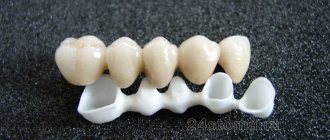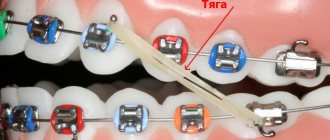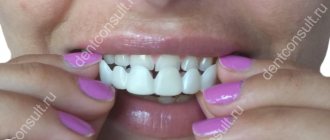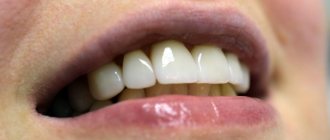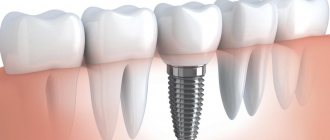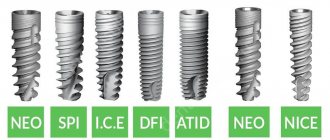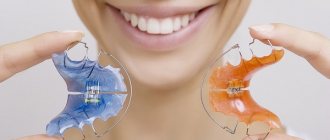A beautiful smile is a person’s calling card. The condition of your teeth affects not only your physical but also your mental health. It is also an indicator of success.
Previously, dentistry used dental crowns to restore even slightly damaged teeth. To do this, they had to sacrifice their natural teeth and subject them to severe grinding. Or remove the coronal part completely.
Now technologies make it possible to eliminate defects on the surface of the tooth, practically without processing it. For this, ultra-thin plates are used that are fixed on the outside of the tooth - veneers. The most popular of them are ceramic veneers, which have a high degree of aesthetics.
What it is?
Despite their ultra-thinness, the strength of the plates is comparable to the hardness of natural tooth enamel. The material allows you to repeat the shape of the tooth with maximum accuracy, hiding visible defects on its surface.
The demand for ceramic veneers is due to their practicality and full compatibility with the human body. The pads are non-toxic, do not cause allergic reactions, and do not require addiction. The translucent material is identical to natural tooth enamel. The shade scale allows you to select the color of the veneers that is similar to the shade of the patient’s teeth.
There are no problems with installing veneers: the plates are attached to the outside of the tooth using a dental compound.
Indications for installation
Veneers are used for a variety of purposes, but all patients expect the opportunity to have a dazzling smile without worrying about the unaesthetic appearance of their natural teeth. Dentists recommend the use of veneers in the following cases:
- Persistent staining of tooth enamel that cannot be whitened in people who smoke and often eat foods with coloring pigments.
- Presence of fluorescent spots. Old fillings placed on the anterior labial surface that have changed color.
- Rough edges, cracked or chipped teeth due to trauma, various types of mechanical damage. In these cases, therapeutic veneers are made.
- Crowding of the front teeth. Slight irregularities, too narrow, large or short teeth.
- Diastemas and tremas are spaces between teeth in different places of the upper and lower dentition.
- Brittle teeth and increased sensitivity to hot and cold foods.
- The patient’s desire to restore worn teeth in the most gentle way.
Often, veneers are made for 6-8 front teeth, and the rest are whitened or prepared for the installation of a bridge or implants. It is important to remember that the use of artificial plates is only a cosmetic technique, before which it is necessary to undergo treatment for caries and other inflammatory diseases of the oral cavity.
pros
Fixing veneers is the fastest and most painless way to restore the aesthetics of teeth. Yes, the teeth are pre-treated. However, turning is no more than 0.5 mm.
The minimum duration of the procedure is associated not only with the immediate installation of veneers, but also with the number of visits to the dentist. If the patient does not require pre-treatment, the entire process will require no more than 3 visits to the doctor.
Important: you should not trust advertising that promises a Hollywood smile using veneers in one session. The plates are made in a dental laboratory based on previously taken impressions of the patient’s jaw. The work is complex, requiring extreme concentration and high professionalism. Therefore, it is impossible to create ceramic veneers in an hour or even in 2 hours.
Some methods of prosthetics require a long period of getting used to new teeth. Overlays do not fall into this category. After fixing microprostheses, unusual sensations may occur due to the appearance of a foreign structure in the oral cavity. But in just a day or two, the discomfort will disappear. Ceramic veneers do not affect the patient’s usual lifestyle, eating and diction.
Long service life is one of the main advantages of the plates. On average, veneers “live” for at least 15-20 years. When used correctly, of course. In addition, microprostheses can be installed in patients with high sensitivity - rejection and allergic reactions are excluded.
How long do lumineers last?
The service life of lumineers, announced by the manufacturer, is 20 years. Naturally, observing all the rules for their careful operation.
EXPERT OPINION
Ask a question Vagapov Zakir Irkinovich Orthodontist, work experience: 16 years “The main advantage of lumineers is that they are easily removable - for their installation the enamel is practically not injured, teeth are ground down only in rare cases, so even after the lumineers fail the patient does not have to immediately engage in restoration – the tooth remains in its original state.”
Disadvantages of the design
The main disadvantage of veneers is the price. For this reason, the procedure is not available to everyone. If we are talking about a minor flaw, then you can choose a more budget option - composite veneers. The material is applied directly to the tooth surface. And under the influence of the light flux, it gradually, layer by layer, hardens, forming a plate.
If the problem is related to darkening of the enamel, you can use a professional whitening procedure. The service is less expensive, but no less effective.
Another disadvantage of plates is the grinding of teeth. No matter what thin ceramic veneers are used, it will not be possible to simply remove the structure from the teeth. You will need to install a new onlay or crown.
Situations that may require replacement of veneers
Old veneers should be removed from teeth and new ones should be installed purely based on the wear of the linings - there are no planned replacement dates or expiration dates after which the veneer would be considered unable to perform its function. If the veneer is intact, does not change color or texture, does not have chips and does not peel off from the tooth stump, then it can be worn further. If any defect appears on it, it must be changed, and immediately upon discovery of this defect, without waiting until any formal deadlines.
Reasons for replacing veneers are:
- chips and cracks in the veneer, peeling it off from the tooth. These mechanical damages are usually visually noticeable, and sometimes also felt by touch with the tongue;
- hue changes. This happens with composite veneers - due to the fact that the original color changes, the veneer becomes too noticeable and different from your own teeth;
- caries under veneer. Alas, this also happens sometimes - even a properly prepared tooth with a well-installed veneer can be susceptible to caries, and then the solution is to remove the onlay, treat the carious lesion and install a new veneer;
- a poorly made veneer that does not match the tooth. Sometimes people come to the VivaDent clinic who have been given veneers that are not the size or shape of their teeth due to an incorrectly taken impression, poor fit, or poor quality work of the dental laboratory. Such veneers objectively interfere - and at the VivaDent clinic they are replaced with new ones that exactly match the teeth.
In what cases are plates installed?
The main purpose of onlays is to eliminate aesthetic defects on the front teeth. It can be:
- Chips and cracks.
- Previously installed fillings that have changed color or cracked.
- Interdental gaps and tooth pigmentation that cannot be eliminated by professional cleaning.
- Pathological abrasion of enamel.
In addition, ceramic veneers help correct minor changes in the bite, crooked teeth, and a decrease in the volume of gum tissue.
Contraindications
Despite the versatility and practicality of the technique, there are limitations to the installation of veneers. For example, the use of plates is contraindicated in cases of bruxism, the presence of inflammatory processes, bone tissue pathology, and malocclusion.
Also, ceramic veneers are not used for the restoration of severely damaged teeth (more than 50%). In this case, the doctor installs crowns.
A refusal to carry out the procedure may be the presence of bad habits (biting nuts, nails, opening bottles with teeth, etc.). Or a high risk of maxillofacial injury. For example, extreme sports.
Gum disease and loss of chewing teeth will also require preliminary treatment before installing plates.
Production technology
Ceramic veneers are usually made using three techniques:
- Applying the composition to a plaster model followed by heat treatment. The dental technician evenly distributes the composition over the surface of a special material that holds the paste during firing. The technique is inexpensive and allows reducing shrinkage of the structure.
- Casting. In this case, a model of future ceramic veneers is first created using wax. Then it is fixed in a refractory mass and installed in the sprue. Processing is carried out under high temperature. At the final stage, the dental technician paints the plates in a color that matches the patient’s tooth enamel.
- Pressing (Emax). More modern technology that reduces the porosity of the material. This ensures maximum structural strength. As a result, pressed plates have a longer service life. After processing, ceramic veneers are coated with a special compound that adds shine to the overlays.
Recently, the digital method of making veneers using a milling cutter has become popular. The model for the plates is obtained using a non-contact scan of the patient's oral cavity. A computer program calculates the structure. The sample is then sent for milling. The advantages of the method are obvious: the automated process eliminates possible inaccuracies and errors in the production of microprostheses.
Diagnostics
The fixation of ceramic plates is carried out in three stages: preparation for the installation of veneers, production of the structure and fixation on the teeth.
Correctly performed diagnostics determines how long the orthopedic structure will serve the patient. In addition to the condition of the teeth, it is important to identify possible hidden pathologies in the bone and soft tissues of the jaw. And also carefully study the anatomical structure of the teeth being restored.
At EspaDent clinics, specialists conduct radiographic examinations for more accurate diagnosis. In complex cases, a modern 3D tomograph is used, which creates three-dimensional, layer-by-layer images of both jaws. During a consultation in our clinics, the doctor will offer the best options for microprostheses and immediately indicate the cost of the procedure.
Pak Roman Vladimirovich
Specialization: orthopedic dentist Work experience: more than 25 years Place of work: Dentistry ROOTT m. Butyrskaya/dd> Specialist in the field of dental prosthetics:
- microprosthetics – veneers, inlays (ceramic, based on precious metals), stump inlays;
- fixed prosthetics with solid cast, metal-ceramic, all-ceramic, metal-ceramic based on drags. metal structures;
- prosthetics on implants;
- removable prosthetics – production of complete, partial, nylon, clasp removable dentures with various types of locking fasteners and a telescopic fixation system.
How does the installation work?
If the patient does not require preliminary treatment, the next step is professional oral hygiene. The dentist removes hard and soft plaque from the teeth and disinfects the oral cavity. Before treating the teeth, the specialist selects the color of future ceramic veneers according to the Vita shade scale. Grinding of teeth is carried out in a gentle manner, without pain. If necessary, safe local anesthesia is used.
Next, the doctor proceeds to taking impressions of the teeth. According to the chosen method, first a model of the plates is made, and then the final microprosthesis. On average, the production of ceramic veneers takes 1-2 weeks, depending on the complexity of the design.
While the patient waits for new veneers, temporary plastic or composite veneers are fixed to the treated teeth. Onlays protect your natural teeth from bacteria. They also provide chewing function before the installation of microprostheses.
After the plates are ready, the doctor fixes them on the teeth one by one. Each dental unit requires approximately 30-60 minutes.
Features of the installation process
Before installing veneers, you should consult your dentist. The doctor must tell the patient about all the features of the procedure and how to use dental veneers.
Reconstruction cannot be done in one visit. The duration of recovery depends on the number of teeth.
Stages of installing veneers:
- preliminary examination of the oral cavity;
- selection of the type of linings according to individual characteristics;
- treatment of the tooth surface (removal of top enamel);
- creating an impression for making a plate;
- overlay of temporary veneers (for the period of production of the onlays);
- removal of temporary products;
- installation of manufactured records.
The procedure has a large number of advantages, but there is one disadvantage that often affects patients’ decisions about providing the service - the possible grinding down of the natural crown. This is necessary to align the tooth surface in relation to other teeth. If grinding occurs, the specialist warns the patient in advance.
Classification of structures
Microprostheses are distinguished by the type of material used in their manufacture. Ceramic veneers, without impurities, are considered traditional. For example, porcelain or pressed ceramics. The advantage of these plates is their impeccable aesthetics. The veneers look natural and neat on the teeth. But ceramics are far from the most durable material. It is not able to withstand significant chewing load.
To increase strength, dentistry has developed zirconium dioxide veneers. In this case, the microprosthesis consists of two layers: a zirconium base and a ceramic lining. Dental crowns are made using the same principle. Important: these plates are metal-free. It is not zirconium (metal) that is used here, but zircon, a natural white mineral. The stone has increased hardness, which allows it to be used to restore lateral teeth. However, the aesthetics of zirconium plates are far from perfect, so after production, an additional layer of ceramic is applied to the veneers. The result is durable ceramic veneers with enamel identical to natural teeth.
The third group includes lumineers - ultra-thin plates. The thickness of the onlays does not exceed 0.2-0.3 mm, which minimizes the process of grinding the teeth. The use of lumineers allows you to hide flaws in the dentition, while preserving the enamel of your natural teeth. The minimum thickness does not affect the functionality of microprostheses in any way. The plates can withstand full chewing load, without chips or cracks. However, there is also a downside: the manufacture and installation of ultra-thin veneers is similar in complexity to jewelry work. High qualifications of both the dental technician and the dentist are required. Which leads to an increase in the cost of the procedure. The cost of making lumineers can be 3-4 times higher than traditional porcelain veneers.
How to extend the wearing period of veneers?
In order for veneers to last as long as possible, you will need to take proper care of them. By following simple rules, you can avoid crown darkening, abrasion or cracking.
- Minimize the consumption of acid-containing products, under the influence of which the surface of the ceramic can change significantly.
- Also, ceramics react poorly to toothpastes with a high pH content or high abrasiveness.
- Despite the fact that the crowns themselves are not subject to caries or plaque accumulation, the teeth are still cleaned during routine procedures. The plates cover only the outer part of the tooth; the back side remains unprotected. Diseases that lead to its destruction will also contribute to the chipping of the crown.
- Even the strongest veneer is installed to improve the aesthetic appearance and still remains fragile. In order for the product to last as long as possible, you will have to reconsider your diet and remove foods that will harm the integrity of the veneer or its coloring. For example, after installing crowns, you should give up solid foods in the form of nuts and those that contain artificial or natural dyes. You will have to reduce the amount of tea, red wine and coffee you drink.
A systematic visit to the dental office, even if upon independent examination of the veneer, everything seems to be in order. Only a dentist can qualifiedly examine the open area of the tooth and the veneer itself for cracks. Regular professional teeth cleaning will also help increase the service life of veneers.
The doctor who installed them will provide additional information on how to increase the service life of the installed veneers. Only he knows which crowns were used, and each type has its own operating requirements.
Sources used:
- “Direct veneers of anterior teeth” (Salova A.V.)
- Principles of operative dentistry. Qualtrough, A. J. E. Oxford, UK: Blackwell Pub. 2005.
- Orthopedic treatment of pathological abrasion of hard dental tissues / Kh.A. Kalamkarov. — M.: Medicine
- "Revised Classification System for Alloys for Fixed Prosthodontics"
Budget analogue
There is an easier and faster way to restore teeth. Composite veneers help with this - a polymer in the form of a paste that is applied directly to the surface of the tooth. The composition is mixed in the dentist's office, which allows you to complete the procedure in one visit. Of course, if there is no need for preliminary treatment of teeth and soft tissues.
The composite has good aesthetics and does not require significant grinding of natural teeth. Hardening is carried out layer by layer, under the influence of light flux. This provides the necessary strength to microprostheses. The technique is suitable for restoring lateral teeth.
Disadvantages of polymer restoration:
- Shorter service life compared to ceramic veneers - no more than 5-6 years.
- Instability to pigmentation. The material changes color over time and absorbs coloring components.
- Imperfect match to the shade of natural enamel.
How much does it cost to install a veneer on 1 tooth?
The price of a veneer per tooth depends on the material and the chosen clinic. The most inexpensive microprostheses are made of composite, but they are also short-lived. Ceramic and zirconium veneers are about the same price. Some professional clinics offer a “turnkey veneers” service, this will help avoid additional costs and risks. For your information, we offer a table with Moscow dentists where veneers can be installed.
| Dentistry | Website | Address | Composite veneer price | Price of ceramic veneer |
| ROOT Center | https://dentalroott.ru |
| from 15,000 rub. | from 37,000 rub. (all inclusive) |
| Implant Ru | https://www.implant.ru |
| — | from 36,000 rub. |
| City-Dent | https://city-dent.rf |
| from 7,000 rub. | from 15,000 rub. |
| The president | https://www.prezi-dent.ru |
| from 11,500 rub. | from 20,000 rub. |
| Center Family Dentistry | https://family-dental.ru |
| — | from 31,000 rub. |
Manufacturers
To protect yourself from low-quality prosthetics, check with the clinic about what materials are used in the procedure. Mainly large companies specialize in the production of ceramic veneers. There aren't many of them.
The most famous company Nobel Biocare is a leader in implantology and prosthetics. It was this manufacturer that developed the popular protocols for implantation procedures All-on-4, All-on-6, Trefoil, etc. In the case of installing veneers, the company specializes in the production of zirconium plates.
The list includes German and Japanese companies that produce their products under the brands Katana, Prettau and BruxZir Anterior. The leader in the production of pressed and solid ceramics is Ivoclar Vivadent, which specializes in Emax technology.
Many years of experience, modern materials and strict quality control allow these companies to occupy a strong position in the dental materials market.
The difference between composite veneers and ceramic
There is no point in trying to choose the perfect option. Each technique has its own advantages and disadvantages. For example, porcelain plates are most effective for restoring the front row of teeth, in the smile area.
On the contrary, the use of composite veneers is indicated for the restoration of chewing teeth. Plus, it's an inexpensive way to restore your beautiful smile. And, as a result, self-confidence. It is advisable to use a composite polymer for point adjustments - 1-2 teeth. While ceramics are effective for the restoration of the entire dentition.
The advantages of ceramic veneers include the quality of adhesion to the tooth surface. The onlays cover not only the front, but also the lateral parts of the dental unit. Due to this, the structure adheres better to the teeth. Ceramics does not lose its original appearance throughout its entire service life. While composite veneers fade, darken, and lose their visual appeal.
There are differences in the installation and maintenance of orthopedic structures. Polymer plates are fixed to the teeth immediately in one session. For porcelain or zirconium, it takes 1-2 weeks to produce the plates. For minor damage, the photopolymer can be corrected by sanding. But if there are chips or cracks, ceramic veneers will have to be replaced.
To maintain the aesthetics of composite plates, you will have to give up bad habits (smoking). And also do not use pigmenting products. In this case, there are no restrictions for ceramics, because the material is stain resistant.
When are they needed?
Veneers are thin coverings that cover the incisal edge of the tooth and its outer part.
They are created to protect the enamel from negative external influences, giving them a well-groomed and healthy appearance. They are used to eliminate the following problems:
- Chips and minor damage to the enamel to prevent consequences.
- The presence of noticeable fillings or gaps between the teeth that require camouflage.
- Incorrect positioning of teeth or minor problems with bite.
- Yellowing or darkening of the enamel, as well as discrepancies in the color of the teeth.
Veneers cannot be placed on the lateral chewing units or canines, because they are intended only for the front rows. Likewise, they are prohibited if the teeth are constantly in contact or if they are severely damaged. In the first case, there is a threat of damage to the products, and in the second, there is simply nothing to attach them to.
Price issue
The cost of ceramic veneers is influenced by the material, installation method, and complexity of the procedure. As well as the qualifications of the doctor and the reputation of the clinic. On average, prices for pressed ceramics start at 23 thousand rubles. Zirconium ones will cost 35 thousand and more, composite ones - from 10 thousand rubles.
If after diagnosis the patient needs dental treatment, the final cost will be higher.
At EspaDent clinics, the patient learns the final amount immediately after the initial diagnosis. No surcharges or hidden fees. For expensive procedures, our patients have the option of interest-free installments. Diagnostics and initial examination in all EspaDent clinics are free of charge.
Care instructions
After dental restoration, you want microprostheses to last as long as possible. This is a completely doable task if you follow the recommendations for caring for ceramic veneers. There are no complicated regulations. The rules are the same as for preserving natural enamel:
- Daily oral hygiene. Use a medium-hard toothbrush and a toothpaste without abrasive particles (not whitening).
- To clean the interdental spaces, it is recommended to use dental floss and rinse your mouth after eating.
- Do not eat too hard foods. Avoid sudden changes in temperature (very hot and cold food).
It is also important to visit the dentist 1-2 times a year for a preventive examination and professional oral hygiene.
In the first days after installation of veneers, unusual sensations may occur due to the appearance of foreign material in the mouth. Especially if the teeth have changed length after prosthetics. But the discomfort will disappear after 1-2 days.
Factors that determine the lifespan of veneers
How long veneers will last depends on several factors:
- the material from which microprostheses are made;
- compliance with operating rules;
- careful care of teeth and gums.
The main aspect affecting the service life of restoration plates is the material from which they are made. The higher its quality, the longer you can wear veneers. Ceramic products with proper care will last at least 8 years, porcelain plates - 20 years or more.
We cannot exclude the human factor, which can either increase or significantly shorten the service life of dental onlays. Not everyone is ready to adhere to the recommendations voiced by the doctor, which sooner or later leads to the destruction of aesthetic products.
Some patients, after veneering, continue to neglect the rules of oral care and refuse preventive examinations by a specialist. Periodontal diseases, caries, pulpitis and other dental problems lead to the fact that veneers need to be changed soon. It is important to carefully monitor the health of your teeth and gums; only with this approach will your smile restoration last a long time.
Lifetime
Depending on the type of structure, the service life is determined. For example, plates that overlap the cutting edge, according to research results, turned out to be a more reliable product.
Overlays made of pressed ceramics are considered to be the most durable. The material is able to retain its original properties for up to 12-15 years, without deteriorating in appearance. Here, it is not the ceramic veneer that wears out to a greater extent, but the cement on which it is attached.
Zirconium plates are not far behind in reliability. Their lifespan is at least 10-15 years. The most expensive lumineers, with proper care, will delight their owner for up to 20 years.
Wear resistance is directly affected by the quality of production and installation of the plates. Porcelain veneers that do not fit tightly to the surface of the tooth can crack or even fall out. And bacteria will accumulate in the space between the tooth and the plate, which will lead to the appearance of carious cavities. Therefore, it is important to carefully choose a clinic and a doctor for prosthetics and dental treatment procedures.
What will happen to veneers in 10 years?
If you have installed high-quality ceramic dental veneers, after 10 years you may not notice any changes at all. The overlays will remain as smooth and white as the day they were installed. Especially with proper care: thorough cleaning and use of professional pastes with a polishing effect.
The main dangers for veneers are mechanical damage and the accumulation of bacteria between the onlay and the tooth. In the latter case, an unsightly black border may appear along the edge of the tooth. If you take care of veneers, their service life can significantly exceed the 10 years “required” for ceramics.
In the case of componeers (composite overlays), after a couple of years you can expect darkening: the overlays become gray and look unnatural. This is how coloring products affect them: tea, coffee, chocolate, berries, beets. In rare cases, componers serve for 10–12 years, but completely lose their presentable appearance. As soon as this happens, you should immediately replace the veneers - the price will be the same as for installation.

